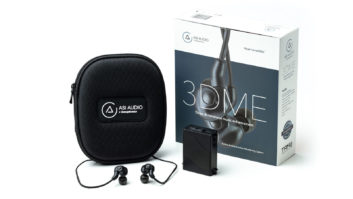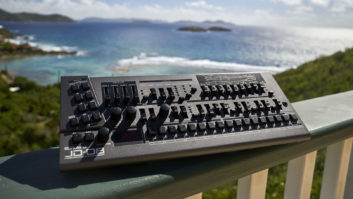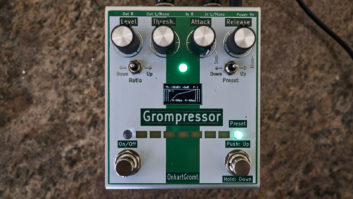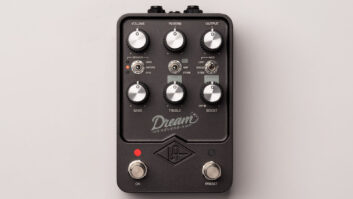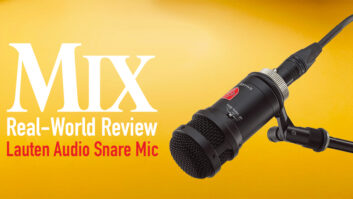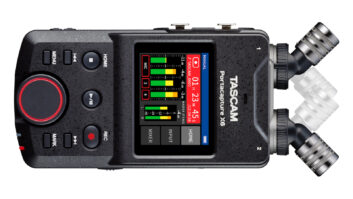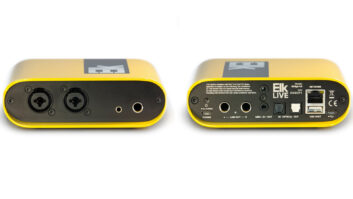
Two DR-680s can be run together bringing the total track count to 12.
In recent years, Tascam has released a range of portable, handheld recorders featuring built-in stereo mics and limited I/O. The DR-680 ups the ante, offering eight inputs, six XLR mic preamps, dedicated outs for each recording channel, S/PDIF digital I/O and the ability to sync to an external clock. The I/Os will perform at 24-bit, 96kHz rates, with the option of recording two channels of stereo PCM at up to 192 kHz. Data is stored to SDHC cards so there are no moving parts. On paper, I see all the makings of a respectable mid-level field recorder, but how does it perform?

I/O includes six analog in/outs and stereo digital S/PDIF ports.
RECORDING MUSIC, VOICE AND FX
My first test of the DR-680 was recording music and voice. A friend wanted to record his grandfather performing some old-time country tunes to be used as source music in an indie film. Grandpa didn’t want to go to a studio so we went to him. I used a pair of Mojave MA-101s in a tight X/Y placement on guitar to avoid picking up too much living room and a JZ V67 for vocals. At 24-bit/96kHz, I was impressed by the sound. Having great mics and recording a voice with wonderful texture certainly played a role. (You can listen to this recording at mixonline.com’s “Mix Media” section.) But a great front end can’t hold up against poor A/D conversion or inaccurate clocking. Fortunately, this is where the DR-680 really shines.
The digital capture was executed with great transparency. The preamps offered plenty of gain without imparting excessive noise. I loved being able to create a 2-channel stereo monitor mix of my three mics and print it to a stereo track while recording the multitracks. This way, I could pull the stereo files and give the artist a reference on the spot without having to mess around with printing a mixdown after the fact.
During this recording, I used the included power supply, as the manual suggested that supplying phantom power to microphones would significantly reduce the unit’s battery life. I was printing to a 4GB Class-4 SDHC card, which was also suggested by the manual. At the time, however, I could not find a card that was included on Tascam’s rather short “tested media” list. I’m not sure which of these factors contributed, but I experienced an error saying “write timeout” several times, and another saying “file not found in take” at the end of a recording. Thankfully, the recordings were on the card when I dumped the files. Nonetheless, these errors were troubling at the time. Lowering the sample rate did not solve the problem. As the manual suggested, I reformatted the card, which may have helped for a while. The problem reappeared other times, inconsistently, usually when recording uninterrupted for durations longer than three minutes.
Meanwhile, I had other successful, error-free sessions recording sound effects while running the unit on eight AA batteries. When operated this way, the recorder is fully functional, with all inputs, outputs and sample rates still available. I used the Holophone H3-D surround mic, which I thought would be a perfect match as the six available mic pre’s would nicely accommodate the H3-D’s six capsules. When recording louder sources, operation was successful, with impressive battery life, fueling the six condensers with phantom power. For quieter sounds, like rain on pavement, a noticeable issue revealed itself, resulting in unpleasant noise. This was perhaps an issue directly related to the H3-D as I didn’t experience it with other mics. I also recorded sound effects with a single phantom-powered shotgun mic. The batteries lasted a little longer than three hours, broken into several sessions. Again, the sound quality was impressive, and the device proved light and comfortable to carry.
FILE MANAGEMENT, TRANSFER
The operating system lets you store three file-naming presets for easy file management. This way, scrolling through letters and numbers to create file names can be handled before the fact and then retrieved quickly as production moves from one scene to the next, or one song to the next. When recording WAV or BWF files, the audio can be grouped into three stereo interleaved pairs, a single 5.1 track or six completely separate mono files. When the user is recording in the MP3 format, recording is limited to four tracks. Transferring files to a computer is very easy. Naturally, you could just pull the SDHC card and transfer the files with an SD card reader. I appreciated the USB 2 connection and how it provided for bus-powered file transfers, even without the power supply connected or batteries in the unit.
Despite the DR-680’s elegant file management and transfer functions, its menus were a little clunky. For example, the menu for basic settings like auto-shut-off, battery type or “Format Memory Card” is available through a button on the device’s large top surface. A completely different Home/Func menu for setting things like low-cut filter and limiter is available from a button on the skinny front panel. And though the front panel also provides access to the mic trims, level controls and pans for the onboard mixer, the track-arm buttons and sample rate selection are stranded back in the menu on the top of the unit (which might be preferable if you’re shoulder-bagging the unit). While engaging the low cut actually takes place in the Home/Func screen, setting its frequency happens in the Menu. It seems as though two different teams worked on the OS in halves and then the two were loosely integrated. Furthermore, guessing which button would page through settings in some of the nested menus was somewhat unpredictable. Hopefully, these annoyances and the actual OS errors I experienced will be corrected in future software updates.
A GREAT LITTLE RECORDER
Aside from a few minor issues, my experience with the DR-680 was very positive. Recording quality is impressive and monitoring well-executed, as the headphone mixer is very easy to grasp. A small speaker lets you reference recordings quickly without headphones. The unit is light, portable and convenient, with enough inputs for most field-recording applications. And if you need more, you can sync two units together using a proprietary protocol. File management and naming are well thought out, and though there are no time-based sync functions, these features are rare on a unit at this price point. If all this suits your needs, then the DR-680 is worth checking out.
Brandon Hickey is an independent engineer and film audio consultant.

Click on the Product Summary box above to view the DR-680 product page.

